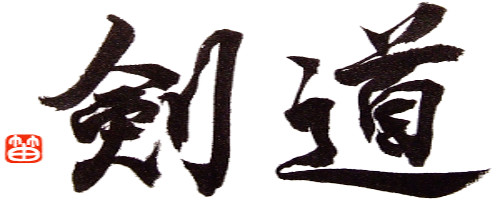Swordsmen in Japan established schools of kenjutsu (the ancestor of kendo), which continued for centuries and which form the basis of kendo practice today.[1] The formal kendo exercises known as kata were developed several centuries ago as kenjutsu practice for warriors. They are still studied today, in a modified form.[2]
The introduction of bamboo practice swords (shinai) and armour (bōgu) to sword training is attributed to Naganuma Shirōzaemon Kunisato during the Shotoku Era (1711–1715). Naganuma developed the use of bōgu and established a training method using the shinai.[3]
In addition, the inscription on the gravestone of Yamada Heizaemon Mitsunori’s (Ippūsai) (山田平左衛門光徳(一風斎)?, 1638–1718) third son Naganuma Shirōzaemon Kunisato (長沼 四郎左衛門 国郷?, 1688–1767), the 8th headmaster of the Kashima Shinden Jikishinkage-ryū Kenjutsu, states that his exploits included improving the bokuto and shinai, and refining the armour by adding a metal grille to the men (head piece) and thick cotton protective coverings to the kote (gauntlets). Kunisato inherited the tradition from his father Heizaemon in 1708, and the two of them worked hard together to improve the bogu until Heizaemon’s death.[3][4]
Chiba Shusaku Narimasa, founder of the Hokushin Ittō-ryū Hyōhō (北辰一刀流兵法), introduced Gekiken (撃剣) (full contact duels with shinai and bogu) to the curriculum of this koryū in the 1820s. Due to the popularity and the large number of students of the Hokushin Ittō-ryū Hyōhō at the end of the Edo-period, this kind of practice contributed greatly to the spread of shinai and bōgu all over Japan. Also there are many waza like Suriage-Men, Oikomi-Men etc. in modern Kendo which were originally Hokushin Ittō-ryū techniques, named by Chiba Shusaku Narimasa for his school.[3][5][6][7] After the Meiji Restoration in the late 1800s Sakakibara Kenkichi popularised public gekiken for commercial gain, but also generated an increased interest in kendo and kenjutsu as a result.[8][9]
Lee Teng-hui, later President of Taiwan, wearing kendo protector as a junior high school student in Taiwan under Japanese rule.
The DNBK changed the name of the sporting form of swordsmanship, called gekiken, (Kyūjitai: 擊劍; Shinjitai: 撃剣, “hitting sword”) to kendō in 1920.[1][10]
Kendo (along with other martial arts) was banned in Japan in 1946 by the occupying powers. This was part of “the removal and exclusion from public life of militaristic and ultra nationalistic persons” in response to the wartime militarisation of martial arts instruction in Japan. The DNBK was also disbanded. Kendo was allowed to return to the curriculum in 1950 (first as “shinai competition” (竹刀競技 shinai kyōgi?) and then as kendo from 1952).[11][12]
The All Japan Kendo Federation (AJKF or ZNKR) was founded in 1952, immediately after Japan’s independence was restored and the ban on martial arts in Japan was lifted.[13] It was formed on the principle of kendo not as a martial art but as educational sport, and it has continued to be practiced as such to this day.[14]
The International Kendo Federation (FIK) was founded in April 1970; it is an international federation of national and regional kendo federations and the world governing body for kendo. The FIK is a non-governmental organisation, and its aim is to promote and popularise kendo, iaido and jodo.[15]
The International Martial Arts Federation (IMAF), established in Kyoto 1952, was the first international organisation after WWII to promote the development of martial arts worldwide. Today, IMAF includes kendo as one of the Japanese disciplines.[16]
